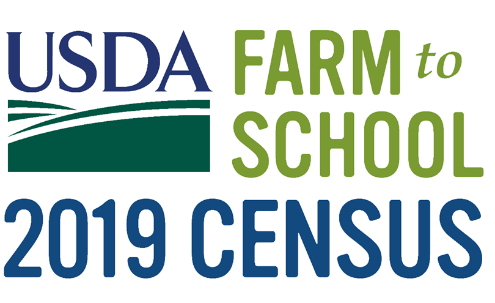|
|
Special Edition, July 2021

|
|

The USDA Food and Nutrition Service (FNS) Office of Community Food Systems (OCFS) is proud to announce the 2021 Farm to School Grant awards! For the 2021-2022 school year, the Farm to School Grant Program will provide $12 million in grants to 176 farm to school projects spanning 45 States, the District of Columbia and four Indian Tribal Organizations – another record year for the Farm to School Grant Program. This is the most projects funded since the program began in 2013. These grants will serve over 6,800 schools and 1.4 million students, almost two-thirds percent (65%) of whom are eligible for free or reduced priced meals.
The 2021 Farm to School Grant awardees represent the resiliency and commitment to local food systems of partners involved in farm to school efforts, including agricultural producers, tribal nations, non-profit organizations, State agencies, and schools serving both rural and urban areas.
“Helping schools expand access to healthy, locally grown produce through these grants is just one of the many ways USDA is transforming America’s food system,” said Agriculture Secretary Tom Vilsack. “Not only will this give children more nutritious food options in school, it supports local agriculture economies, while connecting them to the farms and farmers that grow the food we all depend on.”
Farm to School Grants are awarded annually to help fund projects that increase the amount of local foods served through child nutrition programs, teach children about food and agriculture through garden and classroom education, and develop schools’ and farmers’ capacities to buy and sell local foods.
The Fiscal Year (FY) 2021 Farm to School Grant Request for Applications (RFA) introduced two major changes to the program. The first is a new “Turnkey” grant track with four project choices and simplified application requirements that streamline access to funding for common or priority activities – action planning, edible gardening, agricultural education, and producer-focused training for State agencies. Also new in FY 2021, institutions participating in the Child and Adult Care Food Program (CACFP) and Summer Food Service Program (SFSP) were eligible to apply for funding directly. Awards range in size from $6,000 to $100,000.
Please see the complete press release and list of grantees here. Examples of funded projects include:
-
Sustainable Food Centers, Inc. (Texas), which, in partnership with Texas Department of Agriculture, Common Market, City of Austin, and the Farm to Institution Metrics Collaborative—aims to increase the amount of fresh, healthy, local food in available in rural and peri-urban Central Texas school systems through a three-pronged approach: capacity building for local food procurement and agricultural education; the creation of a peer-to-peer statewide learning collaborative; and piloting an innovative metrics framework to inform ongoing learning and development of farm-to-school programming.
-
New York State Department of Agriculture and Markets, which will research and pilot a web-based technology solution to help food service authorities identify and procure local products, streamline documentation, verify local sourcing and house agricultural education materials.
-
HealthMPowers, Inc. (Georgia) whose project will train over 150 Georgia K-12 schools, early care and out-of-school time centers on comprehensive farm to school programming increasing the number of learning environments that implement farm to school activities and make sustainable policy, system and environmental changes. A dedicated group of 34 schools and centers will receive on-site garden infrastructure, Georgia Harvest of the Month classroom taste test resources, and specialized farm to school technical assistance. An on-demand virtual farm to school resource library will be supported to enable training and long-term sustainability of all sites. At schools and centers statewide, access to local foods will be improved through enhanced agricultural education and support of seasonal menus and local procurement.
Since the program’s inception in 2013, USDA has awarded nearly $64 million through Farm to School Grants, funding a total of 895 projects across all 50 States, the District of Columbia, U.S. Virgin Islands, Guam, and Puerto Rico, reaching over 22 million students in more than 54,000 schools.
|
|
FNS plans to release the RFA for the FY 2022 Farm to School Grant Program in the fall. The annual grant opportunity will help reach more communities seeking to incorporate local products into school meals, integrate agricultural education in the classroom, and cultivate and expand farm to school efforts. Stay tuned for the latest updates on the next Farm to School Grant RFA by following the Dirt and online via the OCFS website.
|

The 2019 Farm to School Census Results are here! USDA FNS is pleased to announce the release the results of the 2019 Farm to School Census; a one-of-a-kind survey of farm to school activity across the United States. Explore results today on the new interactive Farm to School Census website!
The Farm to School Census is a periodic nationwide survey of school food authorities (SFAs) that collects information on the scope of farm to school activity and the overall impact of farm to school efforts across the nation. The Farm to School Census was conducted in 2013 and 2015. For the 2019 Farm to School Census, USDA conducted a nationwide survey of SFAs participating in the National School Lunch Program, and 12,634 SFAs responded to USDA’s questions. These SFAs represented all 50 States as well as American Samoa, Guam, the Northern Mariana Islands, Puerto Rico, the U.S. Virgin Islands, and Washington, DC, and serve more than 40 million students
The SFAs were asked if they were doing farm to school activities based on a broad list that included activities like purchasing local food products, school gardens, education featuring local producers, taste testing and local food promotion and marketing. The results are exciting- farm to school is happening in schools nationwide, and probably happening in a school near you! A majority (65%) of schools responding to the 2019 Farm to School Census reported doing at least one relevant farm to school activity!
While steadily growing over the last ten years, according to survey respondents, farm to school is gaining momentum, as more than half (57%) of the programs reported their farm to school efforts have started within the last three years. Schools are a significant force in the local food system and economic landscape and are poised to make a greater impact in the future. In responses from participating SFAs, those schools estimated that they spent nearly $1.3 billion on local food products used in school feeding programs.
Visit the 2019 Farm to School Census website to explore the landscape of farm to school activity across the country and dig deeper to what is going on across your State and SFA.
To coincide with the launch of the Farm to School Census, USDA has also published The Farm to School Literature Review which summarizes findings from a review of published research on farm to school since 2010 along with the Farm to School Grantee report, which provides an assessment of Farm to School grantee efforts nationwide, focusing on grantee-reported achievements, challenges, and lessons learned. To learn more and access the reports, visit the Farm to School Census and Comprehensive Review webpage.
|
|
|
|
The Dirt is a monthly publication of USDA Food and Nutrition Service, Office of Community Food Systems, providing news and resources for Farm to School Grantees and all readers who want to know what is new and exciting in farm to school.
Learn more at https://www.fns.usda.gov/cfs or contact us at farmtoschool@usda.gov
Not yet subscribed to The Dirt? Join us by clicking here.
|
|
|
USDA is an equal opportunity provider and employer. To file a complaint of discrimination, write: USDA, Office of the Assistant Secretary for Civil Rights, Office of Adjudication, 1400 Independence Ave., SW, Washington, DC 20250-9410 or call (866) 632-9992 (Toll-free Customer Service), (800) 877-8339 (Local or Federal relay), (866) 377-8642 (Relay voice users).
|
|
|
|
|